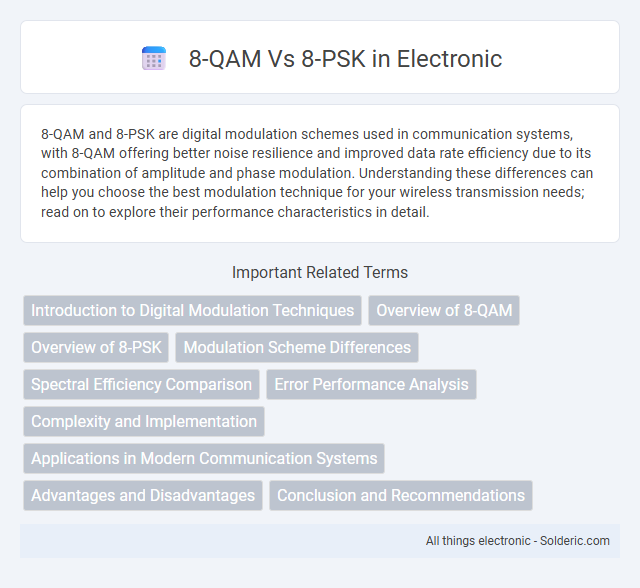8-QAM and 8-PSK are digital modulation schemes used in communication systems, with 8-QAM offering better noise resilience and improved data rate efficiency due to its combination of amplitude and phase modulation. Understanding these differences can help you choose the best modulation technique for your wireless transmission needs; read on to explore their performance characteristics in detail.
Comparison Table
| Parameter | 8-QAM | 8-PSK |
|---|---|---|
| Modulation Type | Quadrature Amplitude Modulation | Phase Shift Keying |
| Signal Constellation | Amplitude and Phase variations | Phase variations only |
| Bandwidth Efficiency | High | Moderate |
| Power Efficiency | Less power efficient due to amplitude variations | More power efficient (constant envelope) |
| Bit Error Rate (BER) Performance | Better in AWGN channels | Higher BER compared to 8-QAM at same SNR |
| Complexity | Moderate modulation/demodulation complexity | Lower complexity |
| Typical Applications | Wireless communication with moderate power | Satellite and wireless where power efficiency is critical |
Introduction to Digital Modulation Techniques
Digital modulation techniques such as 8-QAM and 8-PSK play crucial roles in transmitting data efficiently over communication channels. 8-QAM (Quadrature Amplitude Modulation) combines amplitude and phase variations to encode data, providing higher spectral efficiency compared to 8-PSK (Phase Shift Keying), which relies solely on phase changes. Choosing between 8-QAM and 8-PSK affects your system's robustness against noise and data rate, making understanding their modulation characteristics essential for optimizing digital communication performance.
Overview of 8-QAM
8-QAM (8-Quadrature Amplitude Modulation) combines amplitude and phase variations to encode three bits per symbol, offering improved spectral efficiency compared to simple phase-only modulation schemes. By modulating both amplitude and phase, 8-QAM provides better noise resilience and higher data rates in bandwidth-constrained communication systems. This modulation technique is widely used in digital television, wireless communications, and satellite transmissions, balancing complexity and performance effectively.
Overview of 8-PSK
8-PSK (Phase Shift Keying) modulates data by varying the phase of the carrier signal into eight distinct states, each representing three bits. It offers improved bandwidth efficiency compared to simpler schemes like BPSK but generally exhibits higher susceptibility to noise and errors than 8-QAM due to its closer phase spacing. Your choice between 8-PSK and 8-QAM depends on the balance needed between spectral efficiency and signal robustness for the communication system.
Modulation Scheme Differences
8-QAM (Quadrature Amplitude Modulation) combines amplitude and phase variations to represent data, offering higher spectral efficiency by encoding more bits per symbol compared to 8-PSK (Phase Shift Keying), which relies solely on phase changes. While 8-PSK maintains a constant signal amplitude, making it more resilient to nonlinear distortions, 8-QAM's varying amplitude levels can increase susceptibility to noise and signal degradation. Your choice between these schemes depends on the trade-off between error performance, power efficiency, and bandwidth constraints in your communication system.
Spectral Efficiency Comparison
8-QAM offers higher spectral efficiency compared to 8-PSK by encoding data both in amplitude and phase variations, allowing more bits per symbol within the same bandwidth. 8-PSK modulates only the phase, making it less efficient in terms of bit rate for a given spectral slot. Choosing 8-QAM improves your data throughput while maintaining bandwidth constraints in digital communication systems.
Error Performance Analysis
8-QAM typically exhibits better error performance compared to 8-PSK due to its higher minimum Euclidean distance between signal constellation points, resulting in lower bit error rates (BER) under additive white Gaussian noise (AWGN) conditions. In fading channels, 8-QAM maintains improved robustness as its amplitude and phase modulation scheme allows for more distinct symbol separation relative to the constant envelope 8-PSK. Error performance analysis demonstrates that for equivalent spectral efficiency, 8-QAM offers enhanced reliability, making it preferable in environments requiring efficient and resilient data transmission.
Complexity and Implementation
8-QAM offers a more complex modulation scheme than 8-PSK due to its combination of amplitude and phase variations, requiring precise amplitude and phase control in implementation. In contrast, 8-PSK relies solely on phase shifts, simplifying transmitter and receiver design with less stringent linearity requirements. Consequently, 8-PSK is often favored in systems where implementation simplicity and power efficiency are critical, while 8-QAM enables higher spectral efficiency at the cost of increased hardware complexity.
Applications in Modern Communication Systems
8-QAM and 8-PSK modulation schemes are widely used in modern communication systems for efficient data transmission over bandwidth-limited channels. 8-QAM provides higher spectral efficiency by combining amplitude and phase variations, making it suitable for wireless broadband and digital video broadcasting where data rate and reliability are critical. 8-PSK, relying solely on phase shifts, is commonly employed in satellite communications and cellular networks, offering robustness against noise and simpler implementation at moderate data rates.
Advantages and Disadvantages
8-QAM offers higher spectral efficiency compared to 8-PSK by combining amplitude and phase modulation, providing better noise immunity and improved bit error rate performance under varying channel conditions. However, 8-QAM requires more complex transmitter and receiver designs due to amplitude variations, which can increase implementation cost and power consumption. In contrast, 8-PSK simplifies hardware with constant amplitude signals, reducing nonlinear distortion effects but is more susceptible to phase noise and generally exhibits lower spectral efficiency than 8-QAM.
Conclusion and Recommendations
8-QAM offers better spectral efficiency and error performance compared to 8-PSK due to its amplitude and phase variation, making it suitable for communication systems requiring higher data rates and robustness. 8-PSK, with its simpler phase-only modulation, is easier to implement but suffers from higher bit error rates under noisy conditions. You should choose 8-QAM for applications prioritizing performance in challenging environments, while 8-PSK remains a viable option for simpler, cost-sensitive designs.
8-QAM vs 8-PSK Infographic

 solderic.com
solderic.com